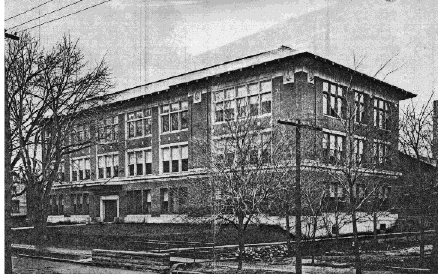


Constructed of brick trimmed with Bedford limestone, the three-story building consists of a main portion adjoined to two end pavilions. On each floor all rooms are united by a central corridor placed slightly behind the longitudinal centerline of the building and terminating halfway into each end pavilion. Originally, the corridors stretched to the end of both pavilions to terminate in large windows. The smaller rooms on the rear half of the central portion are used as offices while the deeper front half and the jutting pavilions provide classroom and laboratory space. Today additional offices occupy the basement and attic.
Designed by W. C. Zimmerman, state architect and designer of the
Armory, the Transportation Building was built in two stages between
1912 and 1921. The land on which the north pavilion would sit was
part of a parcel known as the Conkle estate (1), tied up in litigation with no settlement in
sight at the time of construction. Because the need for classroom
space was pressing, the architect gave approval to construct the
building omitting the north pavilion until the land could be obtained,
at which time construction would be completed as planned. In May 1912
the contract was awarded to low bidder V. Jobst and Sons for
construction of the first stage omitting the north pavilion (2). The work was completed in
four months at a cost of $86,000 and was open in time for registration
on September 16-17, 1912 (3)
The main floor was taken over by the Department of Railway
Engineering, for whom the building was designed. This allowed the
Department of Mining Engineering to temporarily occupy the second
floor and the Department of General Engineering Drawing temporarily
the third. Formal dedication was held May 8-9, 1913, with addresses
by prominent figures in the railway industries. A railway and mining
open house was held in conjunction with the ceremonies. Soon after
the Department of Railway Engineering was phased out in the 1940's,
the building was inherited by the newly declared
Department of General Engineering.
In the early 1960's, the
Aeronautical and Astronautical
Engineering Department< moved in, and in the early 1990's, moved out
again, leaving the General Engineering Department as the sole occupant today.
(4),(5)
The completion of the first stage of the building left the north end
unfinished, with a gable and a blank wall randomly sectioned by
exposed masonry structural members (note
6). The resulting appearance, no
doubt unplanned, seems surprisingly within today's architectural
tastes. The first world war delayed work on the second stage until
1921, when finally the north pavilion covered the wall and the
building achieved its intended symmetry. The corridors probably
extended all the way to the end of the north pavilion now, matching
the south pavilion. The work was completed by the same contractor
that finished the original building, this time supervised by new state
architect James M. White (7). The total cost for the building as completed was $168,000
(8).
Today the Transportation Building presents a unified, decided
appearance. Only a steel door placed in what formerly was a window
detracts from its original intent. Remodeling and partitioning within
has never impinged on its shape or fenestration, except for an
elevator cupola sprouting from the ridgeline and several room air
conditioners parked in the windows.
Exterior brick is arranged in alternating bands, six horizontally laid
courses spacing a course of edge- and end-laid brick. A stone ledge
separates the main floor from the upper stories. The front windows
are arranged in five groups of three on each floor of the main section
and single groups of five on the pavilions. Casings are double hung
with enormous panes, many displaying the telltale distortion of early
glass. Openings vary, from deep recesses punched out of the massive
bearing walls on the main floor to nearly flush stone-trimmed casings
on the upper stories. A flat stone fascia unites the walls with the
massive copper cornicework overhead.
The roof is covered with gray slate shingles laid on horizontal wood
shingle strips. In 1950 the cornicework and slate had to be entirely
replaced due to lack of maintenance brought on by labor and material
shortages during the second world war (9). Recurring water damage eventually necessitated
reinforcement of the wooden attic beams with steel (10).
The front entrance
pierces the center of the building, receding from
the front plane in six successively inlaid bands of brick terminated
by an inner stone portal and an iron door frame. The
opening is protected by a wood and iron roof overhead, suspended by
two ornamental square-linked chains, anchored in the second story wall
by two iron anchor plates suggestive of locomotive wheels. The
railway motif is repeated on the pavilions, in seven winged locomotive
wheels carved in stone and mounted on the fascias. Symmetry
would suggest that the southeast corner should have an eighth, but
early photographs reveal it has never existed, (11) although a corresponding
piece exists on the northeast corner of the 1921 addition.
The front entrance opens into a vaulted vestibule, leading to a lobby
that intersects with the central corridor. Oak beams and corner
pillars frame the intersection. A breezeway through to the rear is
partially obstructed by an elevator facing the lobby, installed in
space that formerly afforded an open view to the glass-walled rear
doorway.
These photos of a fresh, spotless interior were probably taken in 1912
as the tenants were moving in. The photo above shows the main floor
corridor looking north from the south end. The second photo shows the
same view from the breezeway. Note the additional pictures that seem
to have been hung at the north end between the time the first and
second photos were taken.
The photo below shows the breezeway facing west from the rear before
installation of the elevator. Some of the fixtures visible in these
photos are still in use.
Original oak woodwork has been preserved throughout the building in
wainscot lines, window casings, baseboards, doors, and other trim.
Ceiling trim meets the window tops, leaving an inch of space under the
ceiling to further differentiate it from the wall, which is painted
light green to contrast the white ceiling. Names of office occupants
are still rendered by hand in the same style seen in photographs taken
in 1912. (The title graphic of this document uses a very similar font
).
(12)
,
(note 13)
. Transoms over the doors still open, and ancient 8-foot wooden rods for operating them can be found lying around. Light oak floors remain unhidden and largely unrestored in offices and classrooms. Window tops and plasterfaced ceilings still soar to 13 1/2 feet in offices and classrooms, except in the Aeronautical and Astronautical Engineering office where a suspended ceiling has been installed.
For the most part, the temptation has been resisted to jump on the
bandwagon of progress and alter the interior of former drawing rooms
to accompany the arrival of computer labs. Window glare on computer
screens is eliminated with simple black shades instead of bricks,
draped over wooden venetian blinds that face the outside. These
blinds were installed throughout the building by Mackin of
Kankakee in 1946. (14)
Cables for computer lines reside on the surface of the walls as inobtrusively
as possible, usually along the woodwork. The large drawing rooms at
each end of the second floor are still outfitted with original seats
and oak display cases, and many vintage oak-fronted drawing tables
remain in the rooms. If respected, these fixtures could remain for
generations.
Oddly, many electric lines reside on the surface as well. The
original plan called for a level of electrification appropriate to the
occupants of 1912 but which soon proved inadequate. Major electrical
and lighting upgrades took place in 1946, 1961, and 1963. (15)
The main floor is bounded by marble baseboards and covered with
rectangular, saw-sectioned concrete tile, peppered with a black and
white aggregate of quartz and an unidentified black stone. Early
photographs and the level of patina suggest that these are original
materials. A course of solid black tile lines the corridor floor
about a foot from the walls. Irregularities in its path tell of later
changes to the interior: it disappears under the door to
Room 104, which lies in what was once a continuation of the
corridor clear to the window; the course turns back on itself in a closed loop at the
seam between the original building and the later addition; it
disappears under the elevator cubicle, and stops short of the
northeast rear vestibule, which used to be part of a toolroom that
occupied
Room 111 and the north stair spandrel. Other modifications
include remodeling of the southwest drawing room into a plush
auditorium (including the unfortunate exit door) and the partitioning
of classrooms at the south end for Aeronautical and Astronautical offices,
which have since been taken over by the General Engineering Department.
A vault once existed in
Room 101.
Stairways rise from the main floor at the junctures between central
portion and south pavilion, treads cupped with wear. A carved
handrail of oak is supported by iron end posts, each topped with a
locomotive wheel design. The motif of the banister
grillwork is harder to identify; composed of parallelograms linked
with circles, it might suggest boxcars on rails.
The aggregate tile of the main floor rides the stairways to the upper
corridors, pausing in each stairwell to take on a honeycomb shape
until it reaches the next floor, where it has been since covered with
modern asphaltic tile but still peeks out under the drinking fountains
and in the restrooms.
The second floor sports a student
lounge, adapted from a
former classroom that was dragged into an institutional-public-school
design scheme sometime in the seventies and held there by a coat of
indiscriminate orange paint applied to wainscot and radiator alike.
White asphalt floor tile and a fiber ceiling bring it further out of
character with the rest of the building.
Several other areas were remodeled in the early 1960's to provide
office space. In April 1960 funding was approved for limited
remodeling. This was probably to provide office space for the AAE
section, which engulfed the south end of the first floor corridor, and
for what became several faculty offices at the south end of the second
floor corridor. In July 1960 additional funding was approved in the
amount of $2620 to partition Room 308 and the end of the third floor
hall to make room for graduate assistant and faculty offices.(16)
Attic space on the fourth floor was used primarily for storage and
mechanical equipment until the 1980's. A portion of the fourth floor,
from the head of the staircase into the north pavilion, appears to be
as old as the rest of the building, and may have been built as part of
the 1921 addition although Zimmerman's plans do not anticipate it.
The central and south end of the floor were not finished until much
later, as shown by the use of cinder blocks and concrete in the
foyer. Here also the staircase, built in 1981, departs from the earlier work,
following the same form but omitting the railway decor, an
embellishment beyond the concern of the later contractor. In 1986
Room 414 was converted into a computer lab, and in 1989 Room 405
became a technical support workshop. (17)
In 1928 the basement was assigned to Physical Plant, which used it as
an electrical shop (18)
until it was remodeled into offices in 1965 (19). The installation of
the elevator, and the remodeling of rooms eclipsed by its shaft,
accompanied the basement work. This stage of remodeling was performed
by Skoog Construction of Champaign for a grand total of $184,000. (20)
In 1993 the AAE offices moved to Talbot Laboratory, and the General
Engineering department inherited their space. Hopefully, this event
will not spark a remodeling campaign to "modernize" the
building. Already, the installation of central air conditioning in
the main floor lecture rooms has led to the installation of suspended
ceilings. More appropriate was the removal of a faculty office that
had filled the north end of the main floor corridor to create an exit
that leads to an outdoor terrace. This brought the configuration of
the main floor closer to Zimmerman's original intent. Still, the
corridors on the second and third floors remain plugged with office
space, keeping the interior hallways dim. Finally, Room 308, formerly
a large graduate student office, was converted to a senior design
studio and the majority of graduate offices were moved to the
basement.
The Transportation Building lends a sense of authority to the
otherwise hodge-podge assortment of architecture in the Engineering
section. As other buildings suffered insensitive renovations and
additions, this building has repeatedly affirmed its integrity.
Physically, the building is one of the most permanent; in fact, when
the Engineering school was searching for a library building strong
enough to hold shelves upon shelves of books, the Transportation
Building was a leading candidate. A central bearing partition holding
wood-cased doorways with 21-inch jambs (at the third floor level!)
seems thick enough to conceal dumbwaiters. Aesthetically, the
building has been lucky enough to avoid armchair renovators and their
department's trendy whims. Even mechanical equipment has been
carefully located so as not to disturb existing partitions or
windows. Window openings remain intact simply because the strength of
the architecture doesn't seem to allow the thought of bricking them
in. In another hundred years, much will be the same. The TB will not
have come down of its own will, and probably will house another
generation of students and professors in the same dress it met its
first.
Unaltered copies of this work may be made freely for noncommercial use.
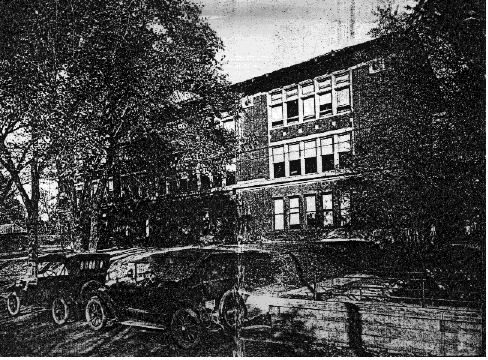
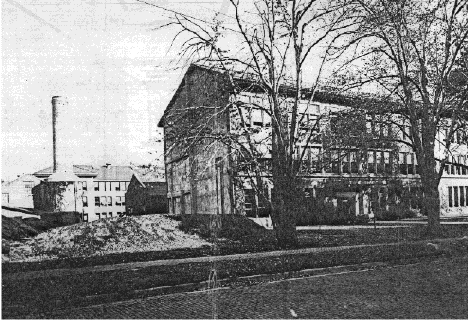
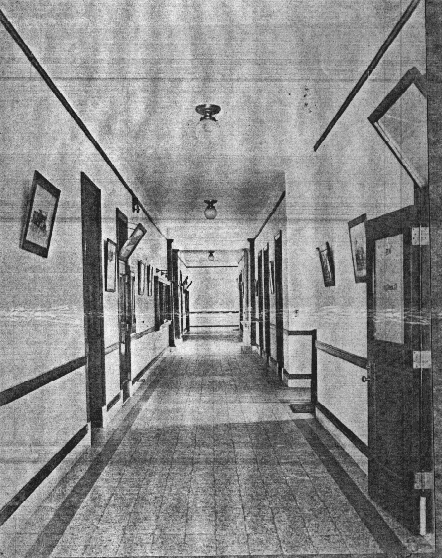
The next two images can be scrolled to the right.
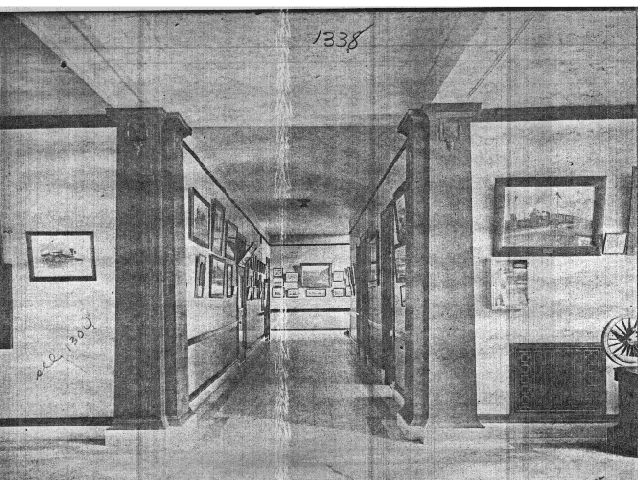
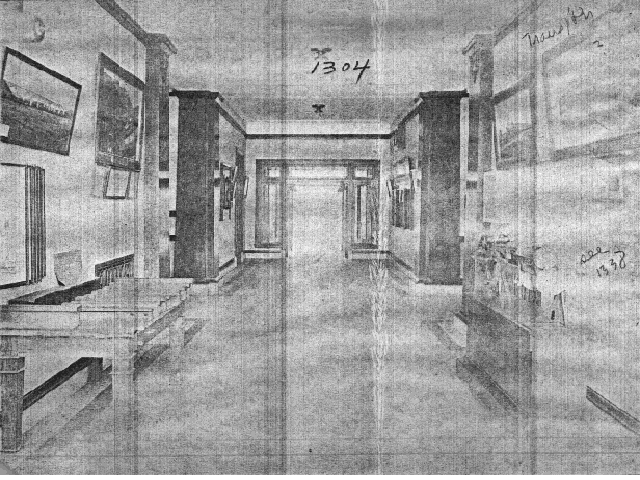
Contemporary photos by the author
mjs@cyberspace.org
Historic photos provided by
University Archives. University Archives has a collection of old
photos, many of which can be reproduced from the original negatives
for a fee.
Notes and References
(1) Transactions of the Board of Trustees, University of Illinois, 1914.
[back]
(2) ibid.
[back]
(3) Baker, I. O. and King, E. E., A History of the College of Engineering of the University of Illinois 1868-1945, Part I. 1945, p. 154.
[back]
(4) ibid and personal observations.
[back]
(5) Inferred from the Board of Trustees records.
[back]
(6) The type of masonry composing the wall is uncertain from the photo but it appears to be concrete or stucco.
[back]
(7) Tilton and O'Donnell, The Illinois Campus Plan, 1867-1930. University of Illinois Press, p. 182.
[back]
(8) Baker and King, p. 154.
[back]
(9) Transactions of the Board of Trustees, May 20, 1950.
[back]
(10) Personal observation from the Mechanical Equipment room at the south end of the fourth floor.
[back]
(11) This is a result of the building's design.
There is less space between the windows and the building corner here
than at other corners, leaving less room for the sculpture. This
shorter, unadorned corner is on the end that faces the Boneyard, where
it is not as highly visible from a main thoroughfare. Photos suggest
that the Boneyard was no more picturesque in 1912 than it is today.
[back]
(Similar font): This font is a shareware
font called, surprisingly enough, "Railroad Roman". It is
available by anonymous ftp from many sites such as
mac.archive.umich.edu. The author of the font mentions that it was
widely used on locomotive equipment at the turn of the century. While
variations of this font are seen in many old buildings, it is tempting
to believe that , in this case, the font was chosen to further the
Transportation Building's railway motif.
[back]
(12) Personal observation.
[back]
(13) In the photo of the main floor hall,
lettering is visible on the door to Room 105. The original print
shows the style clearly. Every semester when new grad students arrive
a sign painter comes along and scrapes the old names off with a razor,
and repaints the new names letter by letter using nothing but a paint
brush and two lines of scotch tape. back to
TB history
(14) Transactions of the Board of Trustees, 1946, p. 400.
[back]
(15) ibid., 1946, p. 961; August 1961, January 1963.
[back]
(Student lounge): By 1991 the lounge was given a makeover to subdue its garish appearance.
[back]
(16) ibid., April 20 and July 26, 1960.
[back]
(17) Personal observation and discussion with professors.
[back]
(18) Baker and King, p. 154.
[back]
(19) Transactions of the Board of Trustees, January 20, 1965.
[back]
(20) ibid.
[back]